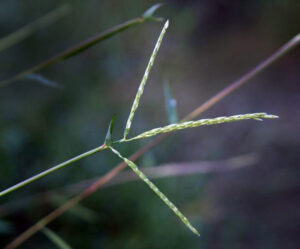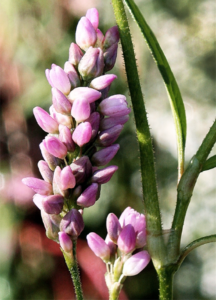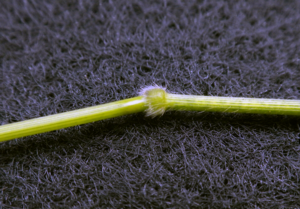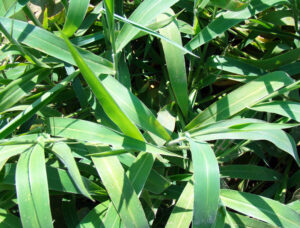By Erika Segerson-Mueller, DNR Invasive Plant Program Specialist, Oshkosh Service Center
Erika.Segersonmueller@wisconsin.gov or 715-492-0391

The slightly off-center silvery midrib of Japanese stilt grass leaves provides a key to identification. / Photo Credit: Leslie J. Merhoff, University of Connecticut, Bugwood.org
Want an advantage over your taller friends? Try propping yourself up on a pair of stilts. As its name suggests, this is precisely how Japanese stilt grass operates. It uses “stilts” (branching rootlets near its base) both as support and to sprawl over nearby plants.
Japanese stilt grass (Microstegium vimineum) is an invasive, warm-season annual grass. It grows one to three feet tall and has an aggressive, mat-like growth that creates dense patches and discourages native plants from establishing. It is also a prolific seed producer, with each plant producing up to 1,000 seeds that can easily spread over land and water during its growing season.
Japanese stilt grass grows well in many light conditions and is often found in disturbed areas. In forests, it crowds out native vegetation, reducing biodiversity and increasing soil erosion. As it dries in the fall and winter, large patches create a distinct, tan-colored dense thatch (matted layers of dead plants) that may increase fuel load for fires.
History Of Japanese Stilt Grass In Wisconsin
To date, there is only one known population of Japanese stilt grass in the state. In 2020, a population was found on the Coulee Experimental State Forest in La Crosse County by a botanist volunteering for the Wisconsin Department of Natural Resources’ (DNR) Rare Plant Monitoring Program.
The early detection of this plant allowed for a rapid response. Control and management of the Coulee population is ongoing.

The stems of Japanese stilt grass turn purplish brown in fall, The stems of Japanese stilt grass turn purplish brown in fall, making them a bit easier to spot among lookalikes that remain green. / Photo Credit: Leslie J. Merhoff, University of Connecticut, Bugwood.org
Identifying Japanese Stilt Grass
While grasses can be challenging to identify, Japanese stilt grass has several unique characteristics that distinguish it from common lookalikes. Careful observation of the key features below can assist with identification.
- Leaves: The leaves of Japanese stilt grass are short and wide with smooth edges. Each leaf has a distinct silvery midrib that is slightly off-center.
- Growth pattern: Japanese stilt grass grows in dense mats. Similar native grasses will not form mats but may grow in clumps or single stems.
- Flowers: While generally smaller and not as showy in comparison to typical flowering plants, Japanese stilt grass does flower. Growing in short clusters called spikelets, Japanese stilt grass flowers appear in early to mid-fall and consist of one to three thin branches (spikes) that are one to two inches in length.
Stilt grass has both open-pollinated flowers and closed (cleistogamous) flowers on short branchlets. These closed flowers never open but self-fertilize and create additional viable seed, greatly increasing the likelihood that the plant will reproduce.
-

The open flowers of Japanese stilt grass grow in short spikelets that can consist of 1-3 spikes. / Photo Credit: Chris Evans, University of Illinois, Bugwood.org
Stems: In fall, the stems and upper leaves of Japanese stilt grass turn slight shades of purple to brown, giving the plant its other common name, Nepalese browntop.
The texture of the stems is another key in identification. Stilt grass stems are smooth; native lookalikes such as white grass have hairs at leaf nodes and along the stem.
- Lookalikes: White grass (Leersia virginica) is a common lookalike for Japanese stilt grass and is often found growing right next to it. The leaves of white grass are much thinner and longer than those of stilt grass and lack the silvery midrib that is diagnostic of Japanese stilt grass. White grass also has flower spikes occurring in July in Wisconsin, significantly sooner than the flowers of stilt grass appear. White grass foliage remains green into fall. The nodes of white grass are hairy, unlike Japanese stilt grass, which lacks hairs along the stem.

Smartweeds such as the Pennsylvania smartweed (Polygonum pensylvanica) may appear similar to Japanese stilt grass at first glance but have larger flowers. / Photo Credit: R.W. Smith, MichiganFlora.net
The roots of white grass are much stronger than those of stilt grass. White grass is a perennial, so it has a robust underground root system that is difficult to pull by hand. Stilt grass is an annual and has a fibrous root system that is very easy to pull by hand.
Additional lookalikes may include the smartweed family (Polygonum or Persicaria species) and crabgrass (Digitaria species). Smartweeds have flowers that are white to pink in color and not grass-like. The stems are also fleshy with distinct membranes at the leaf nodes.
Crabgrasses have stems that appear somewhat flattened. Their leaves are typically longer than those of stilt grass and are pointed at the tip.

The nodes of lookalike white grass (Leersia virginica) are hairy. / Photo Credit: R. Schipper, MichiganFlora.net
Reporting Japanese Stilt Grass
Japanese stilt grass is a prohibited species under Wisconsin’s Invasive Species Rule NR40. There is only one known population of this grass in Wisconsin; eradication is still possible.
If you think you have found Japanese stilt grass, please report it to Invasive.Species@wisconsin.gov along with the location, clear photos of the plant and any other important details.

A crabgrass with leaves that are much longer than the leaves of Japanese stilt grass. / Photo Credit: Rebekah D. Wallace, University of Georgia, Bugwood.org
Controlling Japanese Stilt Grass
Small populations can be hand-pulled in late summer before seeds develop. For larger populations, a broad-spectrum systemic or grass-specific herbicide is effective. Be sure to read the full directions on the label for mixing ratios and application rates.
A weed torch can also be an effective way to remove populations of the grass, though it will not impact the seed bank. As with many invasive plants, repeated treatments over several years are necessary for effective control.
